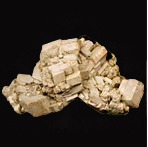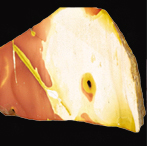Classification of Minerals(8. Silicates-3)
(5) Phyllosilicates
Phyllosilicates have SiO4 tetrahedra linked by sharing three of the four oxygens to form sheets, which result in a pseudohexagonal network based on the sheet composition (Si4O10)4-. They tend to have a platy habit and a prominent cleavage due to the sheet structure. In general, they are soft, flexible, elastic and have a low specific gravity.
Phyllosilicates include the serpentine group (antigorite, lizardite, chrysotile), the clay mineral group (kaolinite, halloysite, montmorillonite), the mica group (muscovite, phlogopite, biotite, lepidolite, margarite), the chlorite group (chlorite), talc and pyrophyllite. The clay minerals are hydrous aluminum silicates, usually in a fine-grained or earthy state. Talc is characterized by its softness, micaceous habit, cleavage and greasy luster. Pyrophyllite is isomorphous with talc, and the two have similar physical properties. Micas are usually tabular and show hexagonal outlines.

Lepidolite Brazil
Lepidolite is a lilac-gray or rose-colored member of the mica group. Its Mohs hardness varies from 2.5 to 3 and its specific gravity is 2.82 to 3.7. It is associated with lithium-bearing minerals in granite, pegmatite and quartz vein. It occurs mostly in Brazil, Russia, Canada and Madagascar. It is a main ore mineral of lithium and used in the manufacture of heat-resistant glass.

GyroliteIndia
Gyrolite most commonly occurs as a secondary mineral in hdrothermally basalt. It is also found in pegmatite dike intruding limestone. Its Mohs hardness is 2.5 and its specific gravity is about 2.45-2.51. It is transparent to translucent. Its is colorless, white, yellow and brown in color. It commonly forms grape-like aggregates of rounded nodules. It is associated with okenite and quartz.

Apophyllite India
Apophyllite is a transparent to transluscent phyllosilicate mineral with vitreous luster and colorless or greenish tint. Its Mohs hardness varies from 4.5 to 5 and its specific gravity is about 2.3-2.4. It can be megascopically identified on the basis of crystal shape, color, luster and basal cleavage. It is typically found as secondary minerals lining vesicles in basalt, often associated with zeolite, calcite, and datolite. Apophyllite tends to exfoliate when ignited, a term named after Greek words meaning 'from' and 'a leaf'.
(6) Tectosilicates
Tectosilicates comprise nearly three quarters of the earth's crust. They have a framework of SiO4 tetrahedra with each oxygen linked to a silicon atom in a neighboring tetrahedron, which results in a stable and strongly bonded structure with the ratio of Si:O=1:2. Except the SiO2 group members like quartz, they are alluminosilicates. In general, tectosilicates without impurities tend to be colorless, white or pale gray. They are rather low in specific gravity and their Mohs hardness varies between 4 and 6.
Tectosilicates include the SiO2 group (quartz, tridymite, cristobalite, coesite, stishovite), the feldspar group (sanidine, orthoclase, microcline, plagioclase series), scapolite, the feldspathoid group(leucite, nepheline, sodalite, cancrinite), the zeolite group (heulandite, laumontite, chabazite, stilbite, natrolite), danburite and petalite.
Quartz is the most common and widespread among the SiO2 group minerals. The feldspars are the most abundant of all minerals. The feldspathoids are a group of sodium and potassium aluminosilicates that are chemically similar to the feldspars. The zeolites are composed of an open and wide-meshed (Si, Al)O2 framework.

Sodalite Gilju, North Korea
Sodalite is a rich royal blue tectosilicate mineral widely used as an ornamental gemstone.

Orthoclase Goseong, Korea
Orthoclase is a type of potassic feldspar, also known as K-feldspar. It is usually short prismatic and white or pink with vitreous luster and white streak. It represents one of major rock-forming minerals in granite and other igneous rocks.

Jasper Australia
Jasper is an aggregates of microgranular quartz and/or chalcedony and other mineral phases. Jasper shows various colors such as red, yellow or green. Our Jasper specimen shows red color due to minor impurities of hematite.